

Jaak Panksepp. Jaak Panksepp (on the right) at the promotion of honorary doctors at the University of Tartu (December of 2004).
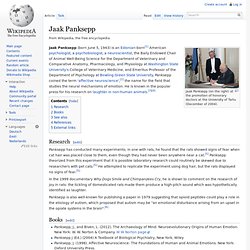
Jaak Panksepp (born June 5, 1943) is an Estonian-born[1] American psychologist, a psychobiologist, a neuroscientist, the Baily Endowed Chair of Animal Well-Being Science for the Department of Veterinary and Comparative Anatomy, Pharmacology, and Physiology at Washington State University's College of Veterinary Medicine, and Emeritus Professor of the Department of Psychology at Bowling Green State University.
Panksepp coined the term 'affective neuroscience',[2] the name for the field that studies the neural mechanisms of emotion. He is known in the popular press for his research on laughter in non-human animals.[3][4] Research[edit] In the 1999 documentary Why Dogs Smile and Chimpanzees Cry, he is shown to comment on the research of joy in rats: the tickling of domesticated rats made them produce a high-pitch sound which was hypothetically identified as laughter. Books[edit] Semir Zeki. Da Wikipedia, l'enciclopedia libera.

Tra i suoi principali interessi ci sono l’organizzazione del cervello visivo dei primati. Ha pubblicato il suo primo articolo scientifico nel 1967 e da allora ha scritto oltre 150 articoli e tre libri: A Vision of the Brain (Una visione del cervello, 1993), Inner Vision: an exploration of art and the brain (Una visione interiore; un’esplorazione di arte e cervello, 1999), tradotto in 6 lingue, e La Quête de l’essentiel, (La ricerca dell’essenziale), del quale è coautore insieme al defunto pittore francese Balthus. School of Communication, Northwestern University. Department of Communication Sciences and Disorders Professor of Neurobiology & Physiology, Otolaryngology, Hugh Knowles Chairnkraus@northwestern.edu Frances Searle Building 2240 Campus Drive, Room 2-346 Evanston, IL 60208-2952 847-491-3181 Graduate Programs: Communication Sciences, Neuroscience Nina Kraus investigates the neurobiology underlying speech and music perception and learning-associated brain plasticity.

She studies normal listeners throughout the lifespan, clinical populations (poor-readers; autism; hearing loss), auditory experts (musicians, bilinguals) and an animal model. In addition to being a pioneering thinker who bridges multiple disciplines (aging, development, lieteracy, music, and learning), Dr. Kraus is a technological innovator who roots her research in translational science.
Lab Affiliations. Piergiorgio Strata: Homepage. Daniel Schacter. Daniel Lawrence Schacter (born June 17, 1952 in New York) is an American psychologist.
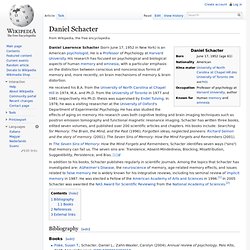
He is a Professor of Psychology at Harvard University. His research has focused on psychological and biological aspects of human memory and amnesia, with a particular emphasis on the distinction between conscious and nonconscious forms of memory and, more recently, on brain mechanisms of memory & brain distortion. He received his B.A. from the University of North Carolina at Chapel Hill in 1974, M.A. and Ph.D. from the University of Toronto in 1977 and 1981 respectively. His Ph.D. thesis was supervised by Endel Tulving. Amazon. Carlo Semenza. Tim Shallice. Wolf Singer. Max Velmans. Max Velmans (born 27 May 1942) is Emeritus Professor of Psychology at Goldsmiths, University of London.

He co-founded the Consciousness and Experiential Psychology Section of the British Psychological Society in 1994, and served as its chair from 2003 to 2006. Michael Posner (psychologist) Michael I.

Karl H. Pribram. Karl H.
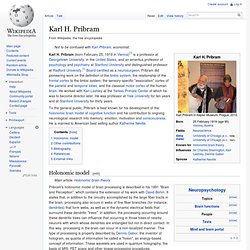
Pribram (born February 25, 1919 in Vienna)[1] is a professor at Georgetown University, in the United States, and an emeritus professor of psychology and psychiatry at Stanford University and distinguished professor at Radford University.[1] Board-certified as a neurosurgeon, Pribram did pioneering work on the definition of the limbic system, the relationship of the frontal cortex to the limbic system, the sensory-specific "association" cortex of the parietal and temporal lobes, and the classical motor cortex of the human brain. He worked with Karl Lashley at the Yerkes Primate Center of which he was to become director later.
He was professor at Yale University for ten years and at Stanford University for thirty years. Holonomic model[edit] Vilayanur S. Ramachandran. Vilayanur Subramanian Ramachandran (born 1951) is a neuroscientist known primarily for his work in the fields of behavioral neurology and visual psychophysics.
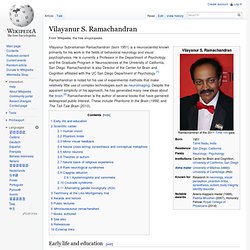
He is currently a Professor in the Department of Psychology and the Graduate Program in Neurosciences at the University of California, San Diego. Ramachandran is also Director of the Center for Brain and Cognition affiliated with the UC San Diego Department of Psychology.[1] Ramachandran is noted for his use of experimental methods that make relatively little use of complex technologies such as neuroimaging. Despite the apparent simplicity of his approach, he has generated many new ideas about the brain.[2] Ramachandran is the author of several books that have garnered widespread public interest.
These include Phantoms In the Brain (1999) and The Tell-Tale Brain (2010). Oliver Sacks. Oliver Wolf Sacks, CBE (born 9 July 1933) is a British-American neurologist, writer, and amateur chemist who is Professor of Neurology at New York University School of Medicine.
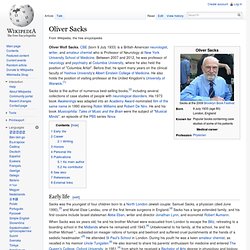
Between 2007 and 2012, he was professor of neurology and psychiatry at Columbia University, where he also held the position of "Columbia Artist". Before that, he spent many years on the clinical faculty of Yeshiva University's Albert Einstein College of Medicine. He also holds the position of visiting professor at the United Kingdom's University of Warwick.[1] Early life[edit] Sacks was the youngest of four children born to a North London Jewish couple: Samuel Sacks, a physician (died June 1990),[3] and Muriel Elsie Landau, one of the first female surgeons in England.[4] Sacks has a large extended family, and his first cousins include Israeli statesman Abba Eban, writer and director Jonathan Lynn, and economist Robert Aumann.
Todd C. Sacktor. Melbourne School of Psychological Sciences. Book Chapters Pre-surgical diagnostics.

Neuropsychology in the Care of People with Epilepsy. John Libbey Eurotext Ltd. 191-200. 2011 From a-Synucleinopathy to Executive Dysfunction: Early-Stage Parkinson's Disease. Development of Executive Functions Across the Lifespan. Refereed Journal Articles Clinical measures of prospective memory in amnestic mild cognitive impairment. John C. Marshall. John C. Rodolfo Llinás. Rodolfo R. Llinás (born 1934) is a Colombian neuroscientist, and currently the Thomas and Suzanne Murphy Professor of Neuroscience and Chairman of the department of Physiology & Neuroscience at the NYU School of Medicine.
He attended the Gimnasio Moderno school and received his MD from the Universidad Javeriana, Bogotá in 1959 and his PhD in 1965 from the Australian National University working under Sir John Eccles. Llinás has published over 500 scientific articles. Early life[edit] Detlef B. Linke. Detlef Bernhard Linke (* 1945 in Hohenfinow-Struwenberg (Brandenburg) (auf der Flucht); † 6. Februar 2005) war ein deutscher Hirnforscher. Linke studierte Medizin, Philosophie und Kommunikationswissenschaften. Er promovierte über psychomotorische Epilepsie und verfasste seine Habilitationsschrift über die Sprachzentren des Gehirns.
Benjamin Libet. Benjamin Libet (/ˈlɪbət/;[1] April 12, 1916, Chicago, Illinois – July 23, 2007, Davis, California) was a pioneering scientist in the field of human consciousness. Libet was a researcher in the physiology department of the University of California, San Francisco. Joseph E. LeDoux. LeDoux's research interests are mainly focused on the biological underpinnings of memory and emotion, especially the mechanisms of fear. LeDoux is also a singer and guitarist in the science-themed rock band The Amygdaloids.[2] Synaptic Self[edit] Published in 2002, Ledoux's Synaptic Self attempts to synthesize his research in neuroscience and on the brain in order to begin tackling the big question he feels neuroscience should be asking: "What makes us who we are?
" Marcel Kinsbourne. Marcel Kinsbourne (born 1931)[1] is an Austrian-born pediatric neurologist and cognitive neuroscientist who was an early pioneer in the study of brain lateralization.[2] He is presently a Professor of Psychology at The New School in New York City[3] and is also affiliated with The Center for Cognitive Studies at Tufts University.[4] Dr. Kinsbourne obtained his M.D. degree (styled B.M., BCh., Oxon.) in 1955 and D.M. degree (a "higher doctorate" based on original research) at Oxford University in 1963, where he served on the Psychology Faculty as of 1964 before relocating to the United States in 1967.
Eric Kandel. Nicholas Humphrey. Nicholas Keynes Humphrey (born 1943) is an English psychologist, based in Cambridge, who is known for his work on the evolution of human intelligence and consciousness. His interests are wide ranging. He studied mountain gorillas with Dian Fossey in Rwanda, he was the first to demonstrate the existence of "blindsight" after brain damage in monkeys, he proposed the celebrated theory of the "social function of intellect" and he is the only scientist ever to edit the literary journal Granta. Humphrey played a significant role in the anti-nuclear movement in the late 1970s and delivered the BBC Bronowski memorial lecture titled "Four Minutes to Midnight" in 1981. Wolf-Dieter Heiss. Wolf-Dieter Heiss. John DeLuca, Neurology, Clinical Medicine, Medicine, Textbooks. Antonio Damasio. Antonio Damasio (born February 25, 1944) is a Portuguese-American neuroscientist/neurobiologist. Jason Walter Brown. Jason W. Allen R. Braun, M.D.
Amazon. Edoardo Boncinelli. Da Wikipedia, l'enciclopedia libera. Edoardo Boncinelli Edoardo Boncinelli (Rodi, 18 maggio 1941) è un genetista italiano. Biografia[modifica | modifica sorgente] Nato da genitori fiorentini, ha studiato e vissuto a Firenze, laureandosi in fisica presso l'Università di Firenze con una tesi sperimentale di elettronica quantistica (relatore: Giuliano Toraldo di Francia).
Dal 1968 al 1992 svolge continuativamente per più di 20 anni attività di ricerca nel campo della genetica presso l'Istituto internazionale di genetica e biofisica del CNR di Napoli, prima come borsista e poi dal 1971 come ricercatore. È stato direttore del laboratorio di biologia molecolare dello sviluppo presso l'Istituto scientifico universitario San Raffaele e direttore di ricerca presso il Centro per lo studio della farmacologia cellulare e molecolare del CNR di Milano.
Ha insegnato Fondamenti biologici della conoscenza presso la Facoltà di Filosofia dell'Università Vita-Salute San Raffaele di Milano.